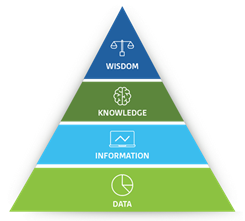The Data-Information-Knowledge-Wisdom (DIKW) Pyramid
The Data, Information, Knowledge, and Wisdom (DIKW) hierarchy is a model that illustrates the transformation of raw data into actionable wisdom. It is often represented as a pyramid, with each level representing a different stage of intellectual processing. From bottom to top, these stages are Data, Information, Knowledge, and Wisdom. Understanding these concepts helps us make sense of how raw facts can evolve into valuable insights and informed decisions.
1. Data: The Foundation
At the base of the pyramid lies Data. Data consists of raw facts, figures, or symbols that, on their own, lack context or meaning. Examples include numbers, dates, or measurements, such as "25," "2025," or "5 kilometers." Data is the raw material that, when processed and analyzed, can become meaningful information. However, in its unprocessed form, data does not provide much value.
2. Information: Contextualized Data
As we move up the pyramid, Information is the next level. Information is created when data is processed or organized in a way that gives it meaning. This step involves adding context, categorization, and structure to raw data. For example, if we know that "25" refers to a person's age, and "2025" refers to a year, and "5 kilometers" represents a distance, we start forming a picture. Information answers "who," "what," "where," and "when" questions and helps us understand the relationships between data points.
3. Knowledge: Insights and Patterns
Above information lies Knowledge. Knowledge arises when we apply experience, learning, and reasoning to the information. It involves the understanding of patterns, trends, and the ability to interpret and connect pieces of information in a meaningful way. In essence, knowledge is applied information. For instance, understanding the impact of a 25-year-old running 5 kilometers in a certain time frame or recognizing trends in people's fitness habits can provide deeper insights. Knowledge allows us to answer "how" and "why" questions, enabling us to make better decisions.
4. Wisdom: The Pinnacle
At the top of the pyramid is Wisdom. Wisdom is the ability to make sound judgments and decisions based on knowledge. It involves using knowledge in a practical, ethical, and thoughtful manner to solve problems, make predictions, and guide action. Wisdom often incorporates foresight, experience, and the consideration of long-term consequences. It answers the question, "What is the best course of action?" An individual with wisdom uses knowledge to solve problems effectively and with empathy, applying the right knowledge at the right time.
The DIKW Pyramid: A Journey of Transformation
The DIKW model helps us understand how basic facts evolve into complex, actionable wisdom. It’s a process of refinement — from raw data to meaningful insights. Each level builds on the one below it, and the transformation relies on human interpretation, analysis, and experience. The DIKW hierarchy is an important framework in fields like information science, knowledge management, and decision-making processes.
In practice, businesses, organizations, and individuals leverage this pyramid to make better decisions, whether it’s analyzing market trends, improving operational efficiencies, or developing strategies. The higher we go in the Pyramid, the more value is added — turning data into something profoundly impactful.

